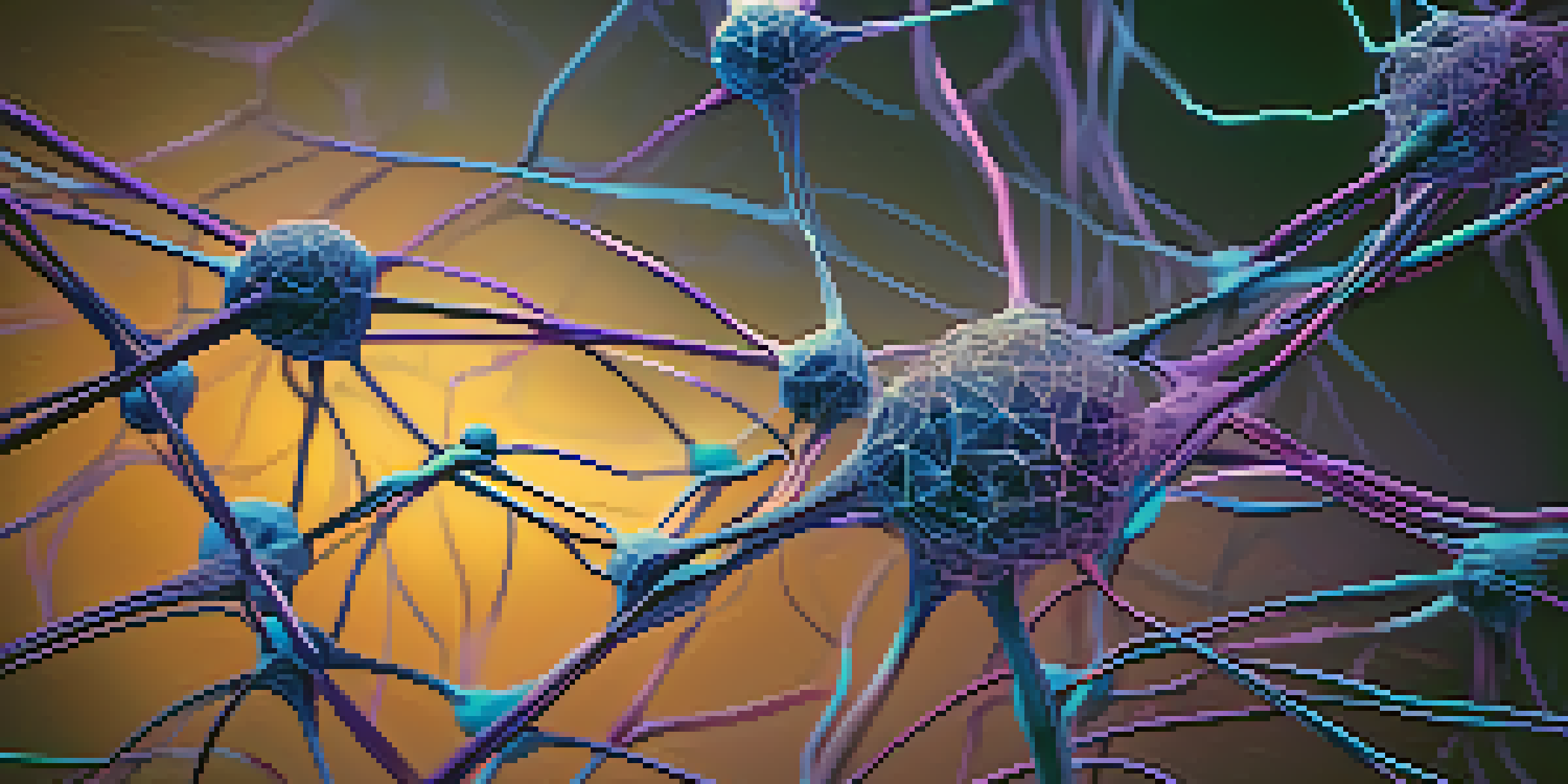Neural Networks and Natural Language Processing Applications

Understanding Neural Networks: The Basics Explained
Neural networks are computational models inspired by the human brain. They consist of interconnected nodes, or 'neurons,' that work together to process data. By learning from vast amounts of information, these networks can identify patterns and make predictions, much like our brains do when we learn from experience.
The great thing about a machine learning model is that it can find subtle patterns in data that humans might miss.
For instance, when you teach a child to recognize animals, you show them various pictures and point out specific features. Neural networks operate on a similar principle, adjusting their connections based on the data they process, gradually improving their ability to recognize and categorize information.
This foundational understanding of neural networks sets the stage for exploring their transformative impact on natural language processing (NLP), an area where they excel in helping machines understand and generate human language.
Natural Language Processing: A Brief Overview
Natural Language Processing, or NLP, is a field of artificial intelligence that focuses on the interaction between computers and human language. It involves enabling machines to read, understand, and respond to text or speech in a way that is both meaningful and useful. Think of NLP as the bridge connecting human communication and machine comprehension.

Applications of NLP are everywhere—from voice-activated assistants like Siri and Alexa to chatbots that handle customer service inquiries. These systems rely on NLP to interpret user input and provide relevant responses, making our interactions with technology feel more natural and intuitive.
Neural Networks Mimic Human Learning
Neural networks learn and improve by recognizing patterns in data, similar to how humans learn from experiences.
The synergy between neural networks and NLP has led to significant advancements, allowing machines to process language with remarkable accuracy and fluency, paving the way for even more sophisticated applications.
How Neural Networks Enhance NLP Capabilities
Neural networks enhance NLP by providing powerful tools for understanding context, sentiment, and meaning. Traditional methods often struggled with ambiguity in language, whereas neural networks can analyze vast amounts of text data to discern subtle nuances. This ability to grasp context allows for more accurate language processing.
Natural language processing is a very important area of AI. It enables machines to understand and interpret human language, making it possible to engage with technology in a more intuitive way.
For example, consider the difference between the phrases 'I love ice cream' and 'I love the cold.' A neural network can analyze the surrounding words and determine that the first statement likely expresses a preference for a dessert, while the second refers to a general fondness for cold temperatures. This level of understanding is crucial for generating coherent and context-aware responses.
As a result, applications like sentiment analysis and machine translation have improved dramatically, thanks to the sophisticated capabilities of neural networks in processing language.
Applications of NLP: Chatbots and Virtual Assistants
Chatbots and virtual assistants are prime examples of NLP applications powered by neural networks. These tools use NLP to interpret user queries and provide relevant responses, making them invaluable in customer service and personal assistance. By leveraging neural networks, these systems can understand natural language more effectively, leading to smoother interactions.
Imagine having a conversation with a chatbot that can not only answer your questions but also understand your tone and sentiment. If you're frustrated, a well-designed chatbot can detect that and respond with empathy, creating a more positive user experience. This level of engagement is a direct result of neural networks' ability to process and analyze language intricacies.
NLP Enhances Human-Machine Interaction
Natural Language Processing allows computers to understand and respond to human language effectively, making technology interactions more intuitive.
As these technologies continue to evolve, we can expect even more advanced features, such as emotional intelligence and personalized interactions, further enhancing their effectiveness.
Machine Translation: Breaking Language Barriers
Machine translation is another remarkable application of NLP that has vastly improved thanks to neural networks. Systems like Google Translate use deep learning techniques to translate text from one language to another, making global communication easier than ever. By learning from millions of examples, these networks can generate translations that are not only accurate but also contextually appropriate.
Consider how translating idiomatic expressions can be challenging for traditional translation systems. Neural networks, however, are trained on a diverse range of texts and can understand that 'kick the bucket' means to die, rather than its literal interpretation. This capability allows for more natural and meaningful translations.
As the technology continues to advance, we can anticipate even more seamless communication across languages, bridging cultural divides and fostering international collaboration.
Sentiment Analysis: Understanding Emotion in Text
Sentiment analysis is a powerful application of NLP that involves determining the emotional tone behind a series of words. Using neural networks, businesses can analyze customer feedback, social media posts, and reviews to gauge public sentiment about their products or services. This insight helps companies make informed decisions and improve customer satisfaction.
For example, a retail brand can use sentiment analysis to identify common complaints in customer reviews and address them proactively. By understanding whether feedback is positive, negative, or neutral, companies can tailor their marketing strategies and product development to better meet customer needs.
Sentiment Analysis Informs Business
Using sentiment analysis, businesses can gauge customer emotions from feedback, allowing them to make data-driven decisions to enhance satisfaction.
The ability of neural networks to accurately assess sentiment not only enhances business strategies but also enriches our understanding of public opinion and trends.
Future Trends in Neural Networks and NLP
The future of neural networks and NLP is brimming with potential, as advancements continue to reshape how we interact with technology. Emerging trends include the development of more sophisticated models that can process multiple languages simultaneously, as well as improved capabilities for understanding context and intent in user queries. This evolution will lead to even more personalized and intuitive user experiences.
Moreover, as ethical considerations around AI and language processing gain traction, researchers are focusing on creating fair and unbiased models. This means ensuring that neural networks are trained on diverse datasets to minimize biases and promote inclusivity in language processing.

With these advancements on the horizon, the possibilities for neural networks and NLP are virtually limitless, promising a future where technology understands and interacts with us in increasingly human-like ways.